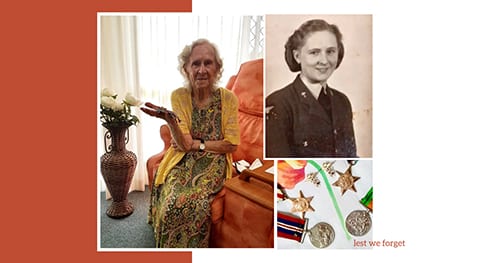At 104, World War II nurse Edith Lord embodies courage and selflessness – the traits of all nurses.
Traits first bestowed by the Mother of Nursing, Florence Nightingale, more than 160 years ago, and whose anniversary nurses around the world celebrate on Wednesday 12 May 2021.
Nightingale, the original ‘Lady with the Lamp’ and legendary founder of modern nursing, is being remembered today on International Nurses Day.
But while Nightingale has left behind a lasting legacy, it remains entwined with lives of nurses like Edith, who is amongst many unsung heroes of the profession.
Edith, who lives at Ozcare in Malanda, is among the last surviving “Flying Nightingales”, nurses who risked their lives to bring back the wounded from the battle fields after D-Day.
A Royal Women’s Airforce (RWAF) recruit and aged just 25, Edith flew into Normandy with little training for the horrors she would face.
She’s rarely spoken of her experiences – her story going largely untold – until now.
These are Edith’s recollections:
“I was born in Liverpool, England, on September 6, 1916, and was the second youngest of seven children,” the centenarian said.
“My father was in the navy. There was a 16-year age gap to my eldest sibling, so my sister Mabel was there when the Titanic left port. I was 25 years old when I joined the British forces, there were quite a few younger than me. We all wanted to do we all could to help the war effort.
“Every day, on the way home from work as an accounts clerk I was climbing over the rubble from the bombings so was getting tired of that.
“For the first four months, I was trained under air force training rules and sent into operation with the air ambulance in England. A few months before the D-Day landings, I was sent to a field hospital at Down Ampney. We were trained on how to treat the wounded in the air.
“We were told we weren’t allowed to use parachutes … if the plane went down, we were expected to help the survivors.
“My first trip to Normandy was D-Day plus three (days). On the way over, there was a medic and four crew. The plane had no doors. It was transporting munitions.
“It took a long time to get there, a few hours, and we had to stand up or sit on the supply boxes.
“We landed at field hospitals to bring the wounded in. They were put into our plane. There was room for 24 stretcher patients and 8 walking wounded. I remember thinking ‘I hope one of them doesn’t die on me’. Some had gangrene and some had their stomachs blown away.
“We had a lot with amputations and had to change their tourniquet on the way back to England.
“Coming back, the trip felt a lot shorter. I was too busy with the patients to be scared. There was a corridor in the sky, but some German planes were over excited.
“We lost one plane, one medic and crew went down. Another plane nose-dived and we lost one girl.
“When we landed, you had to stay with the wounded until the trains took them to hospital. We stayed up all night with some of the shell-shocked ones so we could comfort them. It was just one big family and we all worked in harmony.
“We were always on duty. They would say a plane is taking off at 1am and the snow would come down and you would be shivering on the base. I coped with it. I think it is just something that works for you. I had mixed with a lot of medics as my mother had done some nursing.
“When we were demobbed, I gave my uniform to my sister to make jackets and pants for her children for winter.
“I married Charles ‘Paddy’ Joyce. We met at Down Ampney. He gave me a rabbit’s foot for good luck across the Channel. After the war, Charles took a flat in West London. On the first Sunday of the month, we all met in a park in Windsor Castle.
“There is only one Nightingale left in WA, Margaret Wilson, and I have tried to keep in contact. We are the only ones that have the Florence Nightingale Trophy.
“In 1949, we tossed the coin and I moved to Australia with Charles.
“I have three children, Brian, Maureen and Colleen, and we raised them in Dee Why in Sydney before moving to the Gold Coast.
“In 2008, I was invited to Buckingham Palace to receive the Nightingale trophy but I said ‘I can’t go, I don’t have a hat!’.
“They offered to have the Premier present the trophy but I said ‘No just send it in the post’.
“I’m 104 and five months old now. Charles died 20 years ago. He was discharged because he developed emphysema from his service.
“I lived in Cairns for 18 years in a granny flat behind my daughter Colleen’s home. I moved into Ozcare in 2019.
“I have two grandchildren and four great grandchildren. Another great grandchild is due this month (May).
“My youngest brother died a few years ago, so I am the only one left.”
According to the RAF museum in England, newspaper reporters dubbed the nurses the “Flying Nightingales” and the tag stuck after they were welcomed back from the first casualty evacuation flight after the D-Day landings.
Up to 400 casualties were treated a day at the air ambulance stations across England.
In the first month after D-Day, 1097 stretcher cases and 467 sitting cases were evacuated by the Flying Nightingales from Nos. 48, 233 and 271 Squadrons.
Altogether there were over 100,000 men evacuated by air ambulance after the D-Day landings.
In 2008, the work of the Flying Nightingales was officially recognised with a medal, a lifetime achievement award and a statuette of Florence Nightingale, presented by the Duchess of Cornwall.
The D-Day operation on June 6, 1944, would eventually lead to the liberation of Paris from Nazi control.
A turning point in the war, and human history, the D-Day invasion lasted two months, with more than 4,000 Allied soldiers from Britain, America, Canada and France, most younger than 20 years old, losing their lives in the Nazi occupied France at Normandy Beach.

